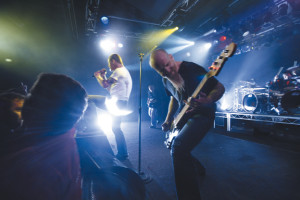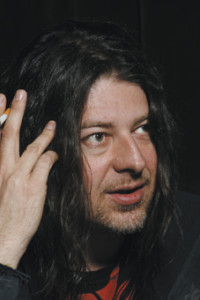STONE SOUR at Soundcheck
June 13, 2007 | Author: Reza Nasseri
 The band includes Slipnot’s Corey Taylor and James Root. The name, Stone Sour, derives from a drink which consists of whisky and orange juice. The sound is … well… let’s call it post-grunge. They don’t wear masks. The venue is Melbourne’s Hi Fi Bar. The activity is sound check. The interview subject is Stone Sour guitarist James Root. The guy firing the questions is Reza Nasseri. The photographer is Marty Williams. That’s all you need to know!
The band includes Slipnot’s Corey Taylor and James Root. The name, Stone Sour, derives from a drink which consists of whisky and orange juice. The sound is … well… let’s call it post-grunge. They don’t wear masks. The venue is Melbourne’s Hi Fi Bar. The activity is sound check. The interview subject is Stone Sour guitarist James Root. The guy firing the questions is Reza Nasseri. The photographer is Marty Williams. That’s all you need to know!
The latest album ‘Come What (Ever) May’ seems to more uplifting and energetic than your previous self titled release which had a notably darker sound. What changed this time around?
This time around we had more time to think things through. We were writing songs while recording “Subliminal Verses”, so we had demos to refine for a year prior to recording the album. Our attitudes changed as well, as did the recording environment and recording process. We recorded our self-titled release pretty much live, with dividers between the amps and drums, and didn’t have luxury of a producer or multiple amp setups and lavish recording gear the first time around. We overdubbed a lot more on this record and created more layers, which resulted in a more polished sound.
I like to think of Stone Sour style as “Post Grunge”, expanding on what the Seattle scene started in the 90’s. How do you describe your sound and what are you aiming to achieve with you music?
It’s very difficult for an artist, and I use that term literally (laughs) to describe what they do. Everyone in the band contributes to songwriting and this troubled me initially, because I thought we had no direction. However, on this album I just started to embrace our differences and accept and enjoy our diverse sound. It’s funny you mentioned the term “Grunge”, because when we were started touring this album we were on the road with Alice In Chains and another reporter labeled us as “Nu-Grunge”, like he was single handedly trying to invent a new genre like “Nu-Metal”, I was horrified (laughs).
So you try to not to label yourselves?
I think there are too many labels in music these days, and some people refrain from listening to a particular band because of the genre they’re associated with. I like to think that there is simply good and bad music out there.
What musical influences form the foundation of Stone Sour?
We all have the same basic influences, but we’re into really different stuff too. Shawn (Economaki) likes weird Chick Corea jazz as well as polished Lindsay Lohan style pop (laughs). Josh (Rand) is our resident metal-head and worships Metallica and Dream Theater, Corey (Taylor) listens to everything from Bob Dylan to obscure punk and 80’s hair metal. Roy is an “old-school” punk rocker who like bands like (Led) Zeppelin and The Who, and I’m kind of like Roy except I listen to modern and classic metal bands like The Haunted and Iron Maiden.
 Songs like “Silly World” cover incredibly diverse musical ground from the Beatles to the Foo Fighters and beyond. How do you go about creating these sounds live?
Songs like “Silly World” cover incredibly diverse musical ground from the Beatles to the Foo Fighters and beyond. How do you go about creating these sounds live?
To me playing live is different to being in the studio, and I think too many bands are trying to re-create what they did on their albums by using pre-recorded material on either DAT tape or in Digital Performer, and are losing their raw edge as a result. Go and listen to a “Who” live album, or go and see Mars Volta live and they might do a 20 minute rendition of a 4 minute track, I mean those guys have balls and some bands need to grow some. I think the average listener will be satisfied if the hear the basic foundation of the songs and sometimes I have to cover 3 guitar parts at once trying do that, but it’s all part of the fun.
How did Roy Mayorga (Soulfly, Sepultura) come to be in the band?
Our previous drummer, Joel Ekman had a lot of personal issues when he lost his son, and needed to get away from the band. Corey and I have known Roy from when he was in Soulfly, and it just so happened he had a week before having to go on tour with Sepultura. So we called him up, and he came into the studio and recorded with us during the day then went home and practiced Sepultura stuff at night. There was a moment in the band where we all looked at each other and thought “This is awesome” and that’s how we got to the next level as a band.
Do you think the personal chemistry within a band affects your abilities as musicians?
I think so, because when you have the sort of communication when you know what the guys are thinking without saying anything, it makes writing easier. Being in a band is like being in a marriage and after 10 years you know what peoples’ farts smell like.
While recording Come What (Ever) May, I understand that Josh was running three miles a day and you (James Root) drank retarded amounts of coffee to get the most out of your takes. Any tips for musicians that are new to the recording process, on how to get a great take when entering the studio?
It’s different for everyone. Some people need to drink wheatgrass or eat vegetarian food, so just do what works best for you. We were on a tight schedule and some nights finished at four in the morning and we had to be back at the studio at 11am the next day. It’s still stressful for me, because unless you’re recording at home it’s not cheap, and unless you’re a studio musician you need to adjust pretty quickly. There’s no hiding in the studio, every nuance of your playing is exposed, where you hear a dry sound in your headphones, so it takes some getting used to.
The spoken word poetry on the last track “Frozen” had me thinking I was in some bizarre David Lynch movie, and a deranged, drunken answering machine message on the track “Blotter”, on your self titled release caught my attention as well. How have albums evolved from when you were a young influential man buying records?
I’m really worried about the future of albums and think they’re going to go away. Originally when rock and roll started out in the ‘50’s, only singles were release due to the technology of the time, and now with I-Tunes and CD’s where you can skip tracks easily, the focus has been shifted away from the album and back to the single. In the “States” we have sold 500 000 physical copies of the album, and if you look at our digital sales on iTunes, “Through Glass” has sold that alone as a single.
How do you deal with “down-time” on the road?
It’s tough, I try to spend as much time checking out the cities we’re in, and over the past nine years have been pretty much everywhere except Africa. Melbourne is pretty cool, there are a bunch of Café’s by the river and cool little markets near our hotel. I love Australia and would be here more often, if it wasn’t so expensive coming down here.
What’s the difference between the Slipknot and Stone Sour fans?
Not much, I see a lot of Slipknot shirts at Stone Sour shows, but at the same time there are a lot of Stone Sour fans that may have heard “Through Glass” on the radio who aren’t aware that Corey and I play in Slipknot too, which is scary.
Tell us about James Root the person. What else do you do besides making music, travelling the world being a rock god?
What else is there? (Laughs) I spent most of my life playing guitar and trying to get where I am now, so when I do have time off I like messing with old cars and motorbikes and restoring them. I’m actually even looking at importing some old Aussie cars like Falcon’s and Charger’s back to the U.S. I like mountain biking too and breaking bones as well.
• Interview with Martin Connors, James ROOT’S guitar tech
So Martin, give us a detailed insight into the signal flow from the moment James’ pick hits the string until the moment the sound travels into our ears.
James is using his own custom made signature series Fender Telecasters, available to consumers towards the end of the year. It’s available with both ebony and maple fret-board’s and features a mahogany body which is very different from the usual alder and ash bodies that Fender use to make their guitars. The guitars are loaded with an EMG ’81 in the bridge and a ’60 in the neck.
We’re using two Orange Rockerverb 100 watt heads into two Orange 4 x 12 cabinets loaded with Celestion Vintage 30’s. All the stomp boxes are controlled through a GTX Midi switching system, so the pedals sit in tray in the rack and are always on but controlled via an onstage midi controller. You also have the option of switching between clean and dirty channels on your heads via midi through one of the 8 loops located within the GTX.
The main effects Jim uses is an Electro Harmonix Small Stone, MXR Phaser, Boss DD-3 and DD-6 Delays, Dunlop 535Q Wah, Rotovibe and Boss NS-2 Noise Gate. The 535 and Rotovibe are inline and are controlled solely by James as is the GTX controller which sits in an onstage pedal-board. No external distortion or equalizers to shape his sound, so the clean and dirty tones come straight from the Rockerverb heads. Jim also uses Audio Technica wireless units controlled via a Whirlwind switching system, which have the ability to run 4 wireless frequencies at any one time.
Usually the sound going to the PA comes from a one of the Orange heads powering a Randall isolation cabinet with a single Vintage 30 inside. There are 2 Audio Technica AT 4050 condenser mike’s positioned inside the isolation cab which needs to be monitored closely because it’s easy to overload the speaker.
James uses 11-56 Dunlop guitar strings (and should have his own custom set coming out through Dunlop soon), tuned to “Drop B” (B, F#, B, E, G#, C# low to high) as well as using Dunlop Jazz III XL guitar picks and a new pick by Dunlop called the “Wedge” which are great for speed picking.






Stay tuned
coming to a new home in 2025



